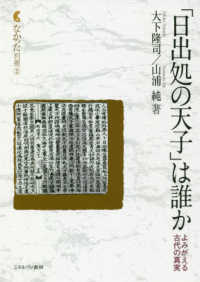Full Description
Latin continued to be used across Europe long after the end of the Roman Empire. This collection considers key issues arising from the use of Latin in Britain from the 6th to the 16th centuries. Latin in this period was not the native language of its users but was nevertheless used extensively for a wide variety of functions from religion, literature, and philosophy to record-keeping and correspondence. It existed alongside a number of everyday native spoken languages, including English, French, and Welsh. The chapters in this collection consider Latin with regard to the various contexts in which it was used, looking beyond narrow comparisons with its Roman ancestor to see what medieval users did with Latin and the changing effects this had on the language.
The fifteen chapters by expert contributors are divided into three parts. The chapters of the first part consider important examples of Latin usage in Britain during four successive periods, the pre-Conquest period, the 12th century, the long 14th century, and the 15th and 16th centuries. In the second part, different spheres of use are considered, including the law, the church, music, and science. In the final part the use of Latin is considered alongside the many spoken native languages of medieval Britain, looking at how the languages had different roles and how they influenced each other. In all the many contexts in which Latin was used, this use reveals continuity matched with adaptation to circumstance, not least in the development of new vocabulary for the language. Between these two poles, users of Latin steered a course that suited their own needs and those of their intended audience.
Contents
1: Richard Ashdowne and Carolinne White: Introduction
Part I
2: David Howlett: The Start of the Anglo-Latin Tradition
3: Neil Wright: The Twelfth-Century Renaissance in Anglo-Norman England: William of Malmesbury and Joseph of Exeter
4: Wendy R. Childs: From Chronicles to Customs Accounts: The Uses of Latin in the Long Fourteenth Century
5: Robert Swanson: Elephans in Camera: Latin and Latinity in Fifteenth- and Early-Sixteenth-Century England
Part II
6: Paul Brand: The Latin of the Early English Common Law
7: Leofranc Holford-Strevens: English Music Theory in Medieval Latin
8: Carolinne White: Latin in Ecclesiastical Contexts
9: Charles Burnett: The Introduction of Arabic Words in Medieval British Latin Scientific Writings
Part III
10: Paul Russell: 'Go and Look in the Latin Books': Latin and the Vernacular in Medieval Wales
11: Richard Sharpe: Official and Unofficial Latin Words in Eleventh- and Twelfth-Century England
12: Laura Wright: On Non-integrated Vocabulary in the Mixed-language Accounts of St Paul's Cathedral, 13151405
13: and#8224David Trotter: Anglo-Norman, Medieval Latin, and Words of Germanic Origin
14: Philip Durkin and Samantha Schad: The DMLBS and the OED: Medieval Latin and the Lexicon of English
15: David Howlett: Making the Dictionary of Medieval Latin from British Sources





